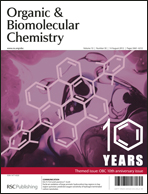Ionization state of the catalytic dyad Asp25/25′ in the HIV-1 protease: NMR studies of site-specifically 13C labelled HIV-1 protease prepared by total chemical synthesis†‡
Abstract
Total chemical synthesis was used to site-specifically 13C-label active site Asp25 and Asp25′ residues in HIV-1 protease and in several chemically synthesized analogues of the enzyme molecule.

- This article is part of the themed collection: Organic & Biomolecular Chemistry 10th Anniversary

 Please wait while we load your content...
Please wait while we load your content...